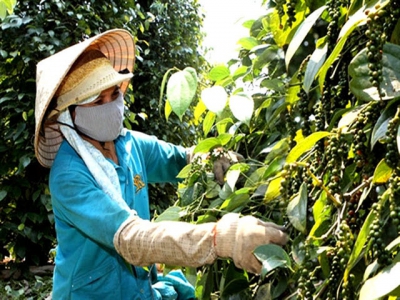Pepper prices become unstable due to faulty information

Pepper prices unexpectedly fluctuated on confusing information, placing difficulties for export.
The pepper prices in the Central Highlands and the southern region fluctuated heavily in the last days of May.
On May 27, the price soared by VND7,000-7,500 per kilogram and reached VND60,000-62,000 per kilogram on May 28. However, it dropped to VND50,000 per kilogram on March 30.
On May 31, the highest price of VND56,000 per kilogram was seen in Ba Ria – Vung Tau, and the lowest, VND52,000 per kilogram was seen in Gia Lai.
The three biggest markets of Vietnam’s pepper are China, the US and India. The US has bought enough products until October. The demand from India is decreasing because pepper processing workshops have cut capacity by 50 percent.
According to Nguyen Tan Hien, deputy chair of the Vietnam Pepper Association (VPA), deputy general director of Tran Chau Trade and Import/Export Service, the story of the pepper price increase began on May 27 and finished on May 29.
Prior to that, the pepper price increased from VND38,000 per kilogram to VND42,500 per kilogram and stayed at the level for some days. Later, it continued to move up to VND48,000-49,000 per kilogram and the market has become chaotic with rumors.
Some petty merchants spread the rumor that export companies are collecting products to fulfill their export contracts, so the pepper price would continue escalating and may reach VND80,000 per kilogram.
On May 26, Son Ha Company in the north raised the purchase price to VND53,000-55,000 per kilogram, but it bought pepper in small quantity.
On May 27, the price jumped to VND60,000 per kilogram and some merchants in Dong Nai, Binh Thuan and Dak Lak bought at VND60,000-63,000 per kilogram.
On May 29, pepper was traded at VND60,000 in the morning and VND52,000 per kilogram in the afternoon. The price dropped further to VND50,000 on the next day.
Hien complained that unstable pepper prices make it difficult for companies to collect materials. More seriously, this creates favorable conditions for Brazil and Indonesia, the two biggest rivals of Vietnam, to boost sales, while Vietnamese companies are still holding products.
According to Nguyen Nam Hai, chair of VPA, the demand and supply in the world remain stable and the prices in the world market have not increased, but the domestic prices increased sharply some days ago.
Hai said the domestic pepper price was affected by rumors, which created ‘virtual price fevers’. In other words, the price increased not because of the higher demand for export. The price increase must not be seen as a sustainable trend.
He also warned that the ‘price bubble’ is not good for export, because export companies cannot buy materials to fulfill export contracts.
The three biggest markets of Vietnam’s pepper are China, the US and India. The US has bought enough products until October. The demand from India is decreasing because pepper processing workshops have cut capacity by 50 percent.
Có thể bạn quan tâm
 Vietnam expected to surpass Thailand in rice exports
Vietnam expected to surpass Thailand in rice exports Vietnam’s rice export volume and value in the last month soared by 47% and 55.3% month-on-month, respectively.
 Ample space for boosting exports of processed agricultural products
Ample space for boosting exports of processed agricultural products Vietnam exported 166 million USD worth of processed agricultural products in the first quarter of 2020, up 33 percent year-on-year, statistics reveal.
 Vietnam’s agriculture to be world’s top 15 most developed
Vietnam’s agriculture to be world’s top 15 most developed Vietnam will strive to be among the world’s top 15 most developed countries in agriculture by 2030 with agricultural processing to rank in the world’s top 10.